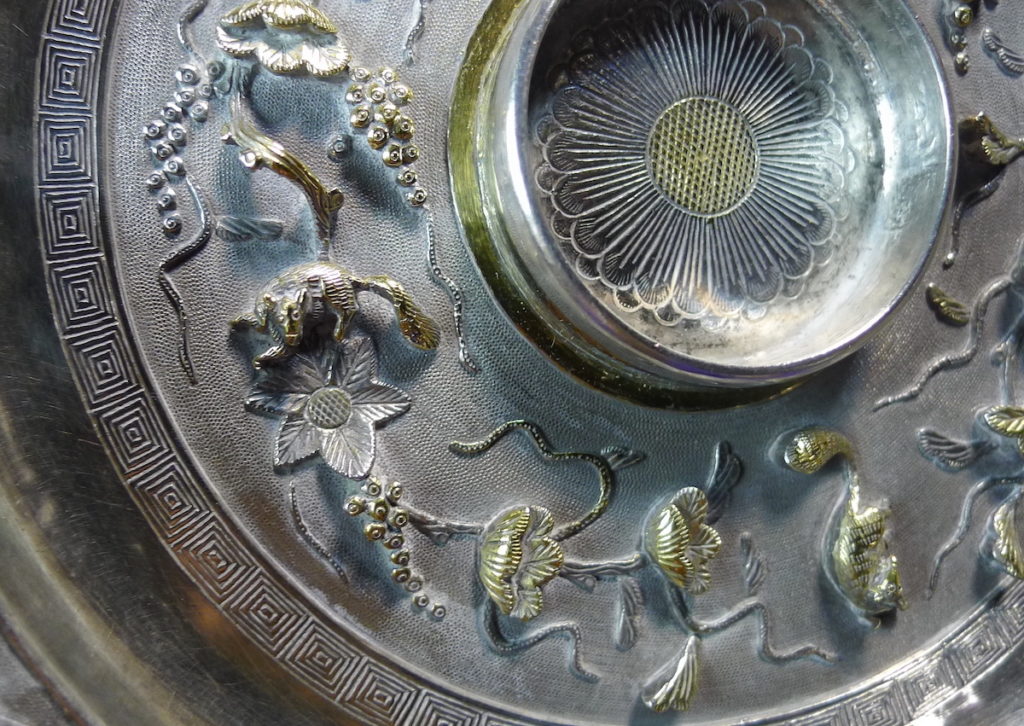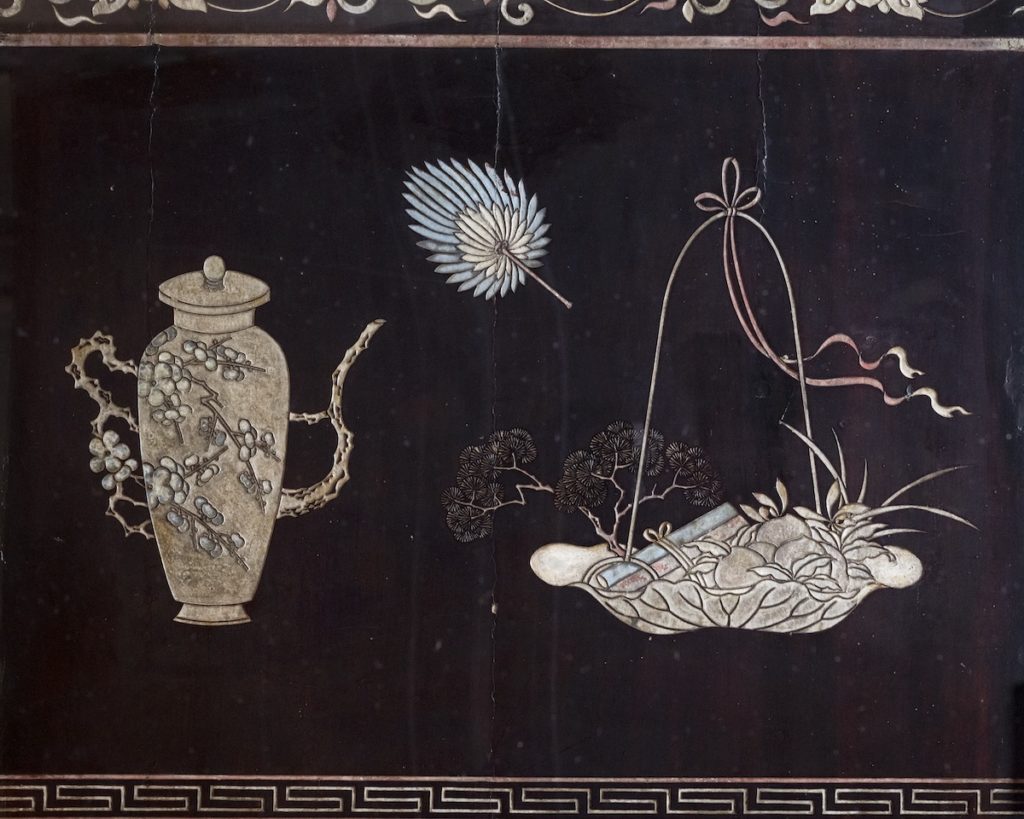Susan Eberhard
“The list of the King’s presents is complete;
if you are not satisfied, that is your problem.”[1]
—Abbé de Choisy, Ayutthaya, November 11, 1685
Introduction: A Silver Chocolatière with a Bamboo Spout
Studies in early modern diplomatic history have focused on the role of gifts in navigating cultural difference and political tension.[2] Craft, material, and presentation of gifts were all invested with strategic intent by their elite givers. In the case of the 1686 diplomatic mission sent from the court of Phra Narai (r. 1656-1688) of Ayutthaya, Siam (now Thailand) to the French court of Louis XIV (r. 1643-1715), scholars have placed special weight on the gold and silver gifts brought by the Siamese envoys. But until recently, no extant precious metal objects were securely connected to the mission.[3] As a result, scholars have focused on the context of exchange over the specific qualities of objects. They have also privileged the European reception of the gifts over their Asian source context. Newly rediscovered in a private collection, a Chinese silver ewer is the first metalware to be verified as a survivor from the 1686 embassy by curators at Versailles (Fig. 1).[4] An examination of the ewer as both craft and sculpture, and its discursive packaging as a gift, reveals how it operated as a cosmopolitan expression of Siamese kingship. In addition, it shows how the cultural translation of the object animated the material mechanisms of diplomatic processes and global aspirations in the period.[5]
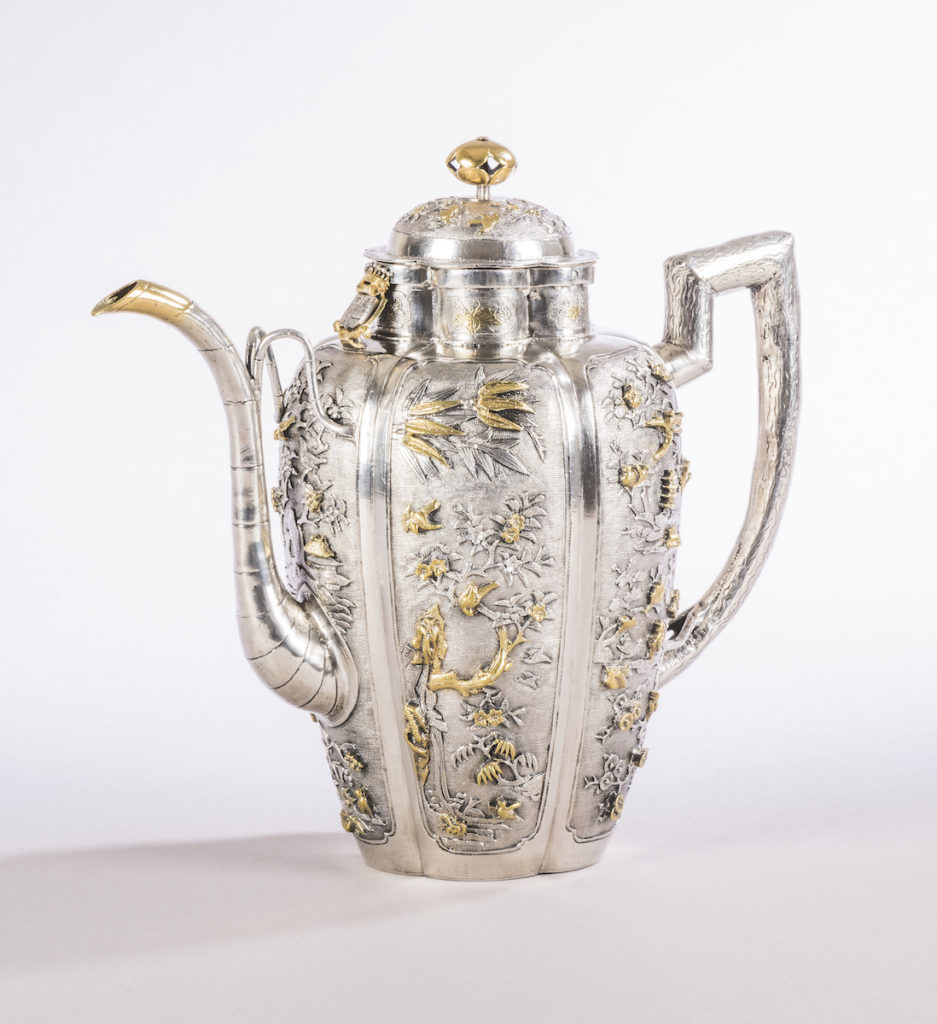
Scholars have argued that the precious metal gifts brought by the Siam ambassadors were political agents that shaped Franco-Siamese relations. The mission arrived at the newly constructed Hall of Mirrors at Versailles with over three hundred bales of gifts, including approximately eighty gold- and silverwares. The diplomat chevalier de Chaumont published an inventory sent with the gifts in his memoir of the mission.[6] Notably, all the precious metalwares were described as being of Chinese or Japanese manufacture. While Giorgio Riello has argued that the objects confirmed Siam’s lucrative commercial access to China and Japan to the French, Meredith Martin has demonstrated that the metalwares stirred up French “gilded dreams” of Siam’s untapped gold and silver mines.[7] The metalwares thus represented two possible economic benefits of a Franco-Siamese alliance. However, existing scholarship has yet to address questions regarding the craft and aesthetic value of the gifts. The resurfacing of one Chinese silver ewer from the cache allows us to move beyond their status as “sample” manufactures and to begin reconstructing the politics of their fabrication and diplomatic framing.
Using multiple inventory marks on the Versailles ewer, Marie-Laure de Rochebrune has traced its documented history in French palace inventories.[8] She argues that in Chaumont’s 1686 diplomatic inventory, the ewer was categorized as one of several chocolatières, or vessels for heating and serving drinking chocolate. Historians have written that the chocolatières brought by the mission were the earliest known examples of the vessel form recorded in France.[9] Chocolate was newly fashionable in Europe, procured through Spanish imperial networks. Based on the object’s form, de Rochebrune notes that it was most likely the item described in Chaumont’s inventory as “Another silver chocolatière, gold flowers, of workmanship in high relief, made in Japan” (“Une autre chocolatière d’argent, fleurs d’or, d’un ouvrage fort revelé, du Japon”).[10] The Chinese ewer was thus positioned as a vessel made by Japanese artisans for the specialized purpose of serving a Mesoamerican drink.
Early modern diplomatic gifts at times traversed incommensurable systems for assessing their value. They had to be multivalent objects that operated on multiple registers. The Versailles ewer is a six-lobed vessel with a gently curved spout, segmented to resemble a bamboo stalk or root. Its handle is chased with whorls of wood grain, fashioned to suggest a twisted pine bough. Each melon-like lobe is decorated with a panel of vertical Chinese landscape scenes in high, partial-gilt relief. By examining the material properties of the object, first in a Chinese context of elite taste, and second in its transformation into a diplomatic gift that imagined the Americas as entangled with Asia, this essay charts one segment of the “social life” of a cross-cultural diplomatic object.[11] The case study suggests shows that the value of objects transiting global contexts was not self-evident, but rather constructed through intermediaries such as envoys and merchants. By tracing the intentions of how objects were packaged for their European recipients, Asian agency—in the form of prior, determinative exchanges between east and southeast Asia—is also highlighted in early modern cross-cultural diplomatic processes.
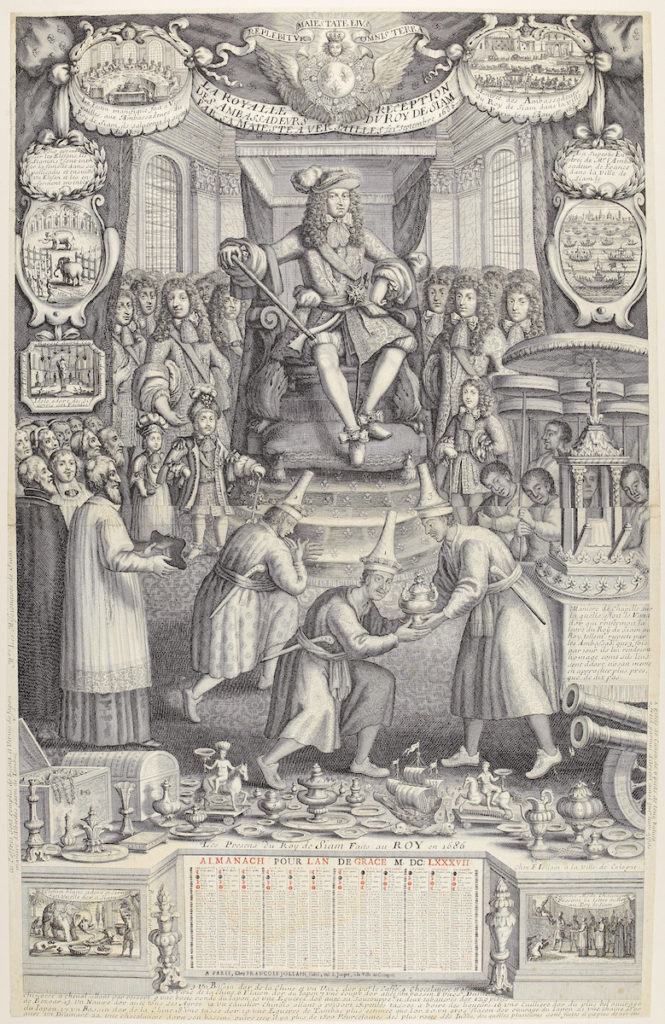
In a prior lacuna of objects, scholars pointed to a print of the embassy attributed to the French artist Pierre Paul Sevin, which shows the Siamese ambassadors placing a cache of gold- and silverwares at the feet of Louis XIV (Fig. 2). A key at the bottom labels many of them, as if to serve as a pictorial inventory. Yet the depictions of the objects suggest that Sevin did not base them on firsthand sketches. Many of the vessels are faceted and lobed, like the Versailles ewer, but most verge on fantastical versions of European forms. One object at left, labeled on the print’s key as number four, a “chocolatière with its cups,” appears to be a perfume bottle with a stopper (Fig. 3). The printmaker seemed aware that chocolatières were listed among the gifts sent by the Siamese court but imagined the form as a closed container rather than a pouring vessel. Shifting from the print’s conjectural objects to object-based evidence, the Versailles ewer allows us to unravel the regional and global articulations of power through which a Chinese pot was reframed as a transpacific vessel.
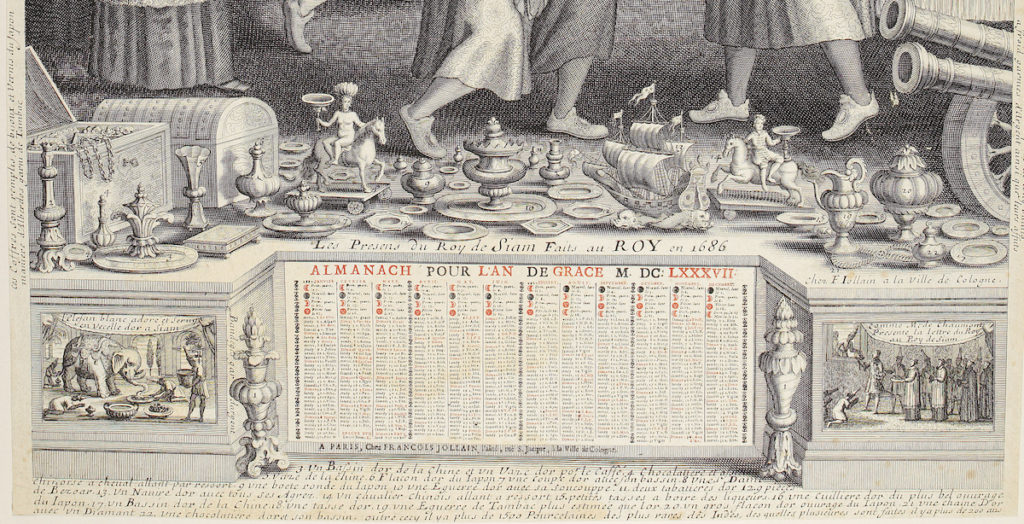
Pine, Bamboo, and Plum: Silver’s “Organic” Aesthetic Potentials
Based on period practices, the Versailles ewer is impractical as a vessel for preparing and serving drinking chocolate. First, it has a narrow foot. Wide-bottomed pots, such as those used in the pre-Hispanic Americas where drinking chocolate originated, are better suited for the purpose of melting and stirring chocolate. The standard form of the European chocolatière in the eighteenth century was a tall vessel with a round base, patterned after Mesoamerican forms (Fig. 4). Further, the ewer lacks a critical Mesoamerican component for preparing the chocolate: a hole in the lid through which a molinet, a rod used to froth sedimented chocolate before serving, could be inserted. In 1687, Nicolas de Blégny, French surgeon-in-ordinary to Louis XIV, noted that vessels used to prepare chocolate resembled a coffee pot, with the important distinction of an opening to insert the molinet.[12] The object’s functional limits suggest that it was initially produced for a different purpose.
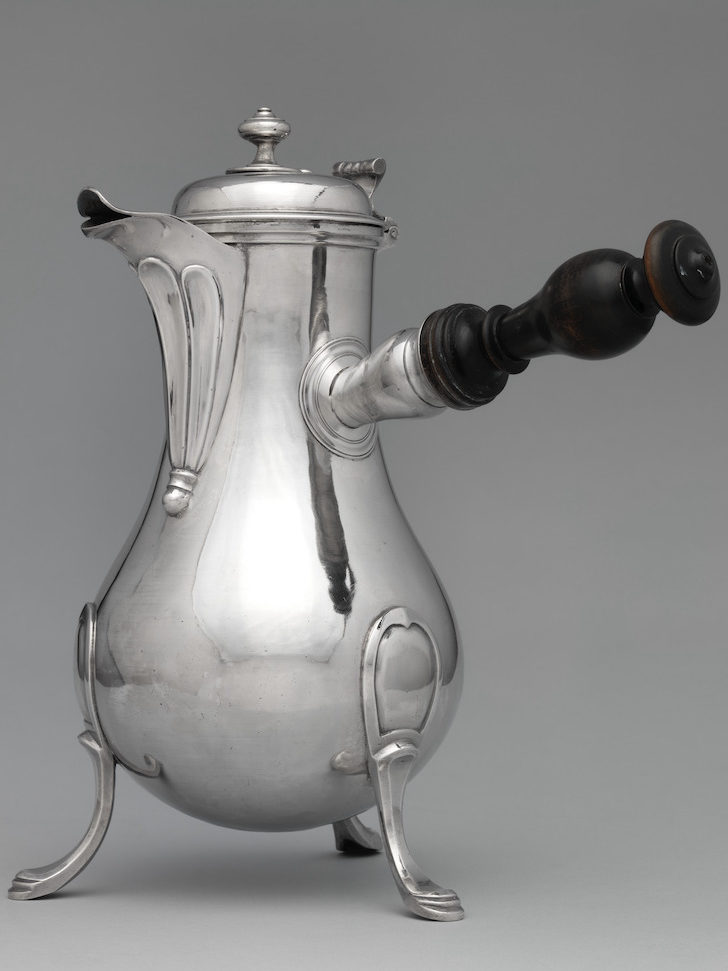
Iconographic analysis reveals how its form and ornament cohere within systems of Chinese auspicious meaning. Not suitable for serving chocolate, in a Chinese context it was likely primarily used to serve wine. Further, its combination of motifs would have made it a compelling gift to express good wishes to an elite male recipient, due to the motifs’ associations with a set of masculine qualities. While its site of production is unknown, the ewer resembles other extant examples produced by workshops in southern China. A similar ewer in the Hermitage Museum was recorded in a 1789 court inventory, but likely entered the collection earlier in the reign of Catherine II (r. 1762-96) (Fig. 5).[13] The form was produced late into the eighteenth century by different workshops, and continued to be used into the early twentieth century by southeast Asian Chinese immigrant communities as a ceremonial wine ewer.[14] Little has been written on the tapering and faceted ewer type with a sinuous spout, primarily because it has been viewed as a form produced for export to Europe. Most extant examples were preserved outside of China, where they were understood as teapots or coffeepots.[15] As a result, their Euro-American reception overshadowed their Asian histories.
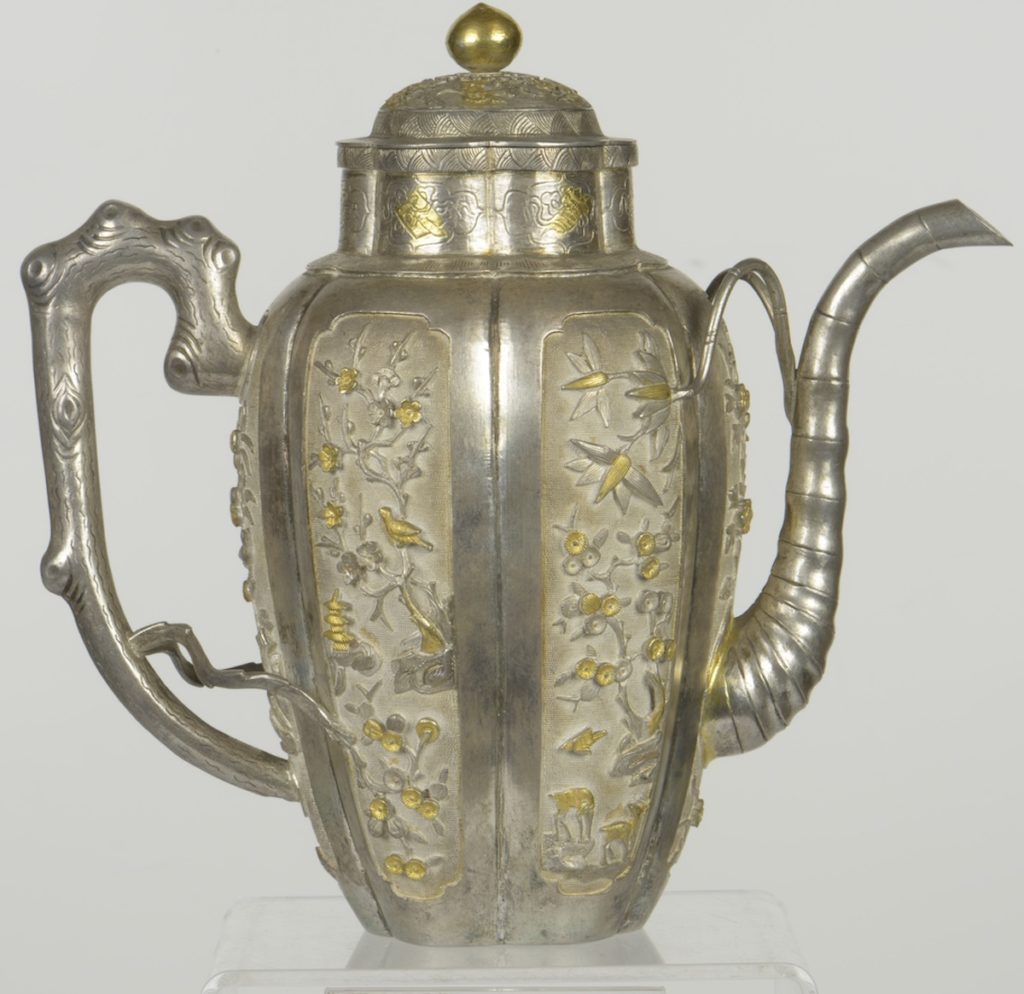
Annette Haug and Adrian Hielscher have written that materials have many aesthetic potentials, which are selectively heightened through different techniques and treatments.[16] Planished silver surfaces could produce reflective effects. By contrast, the makers of the Versailles ewer textured, matted, segmented, layered, and linked its surfaces and appendages. Twisted branches on the surfaces and limbs were made to resemble organic materials constituted through metal. Through the achievement of aesthetic potentials via silversmithing techniques, the ewer’s form would have connoted a set of auspicious meaning among elites in the late imperial Chinese context, corresponding to the late Ming (1368-1644) and Qing (1644-1911) periods.
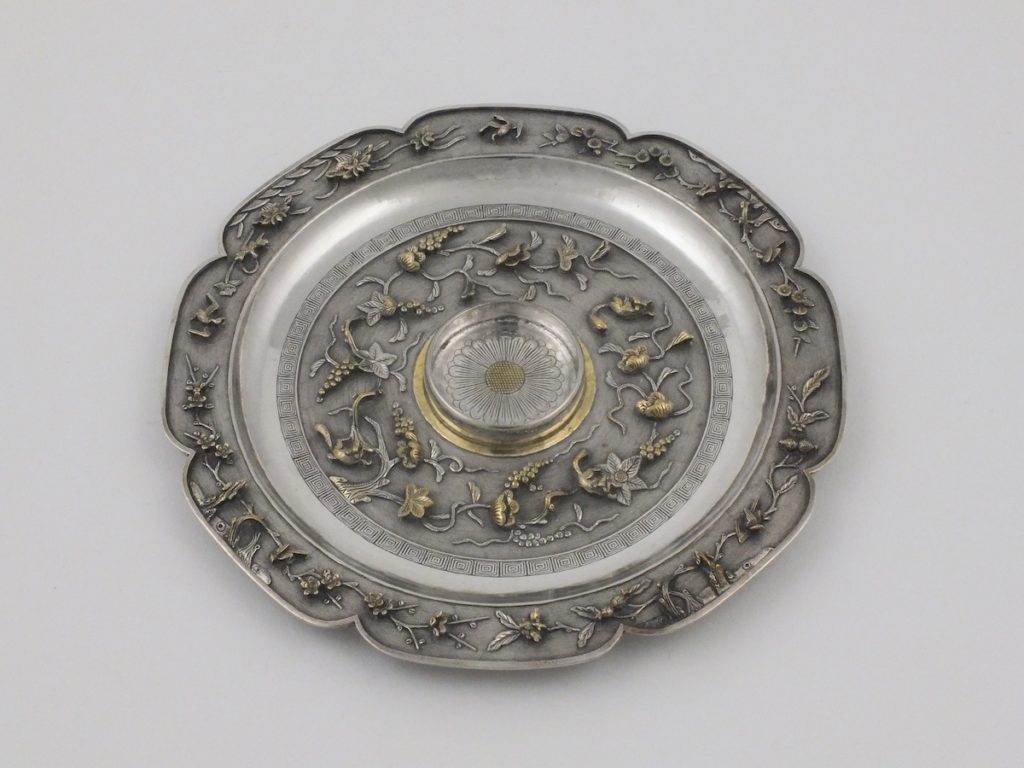
The type of high relief on the surface of the ewer appears on late seventeenth- and eighteenth-century objects attributed to Chinese gold- and silversmiths, such as a cup stand in the Peabody Essex Museum (Fig. 6). The relief was produced by casting and applying tiny pieces of silver, creating a crisp, high-contrast set of effects. In certain areas, the relief lifts off the surface in the form of gnarled tree branches, twisting vines, animal bodies, and flowers in the round (Fig. 7). The technique used was a delicate appliqué, such that remnants of solder used to seal the tiny castings to the surface are barely discernable, even under magnification. On the Versailles ewer, each rounded surface bears a panel of vertical landscape scenes, inset within a foliate frame. On the central panel visible on Fig. 1, two birds flit around the branches of a flowering plum tree, which grows outward from a craggy mountain. Above, two bamboo branches project from the surface, while below, a waterfall flows from the base of the tree. While each of the six compositions are different, the technique is the same: small, raised elements contrast with fine-grained, horizontal punching on the surface. The aesthetic potential achieved is multiple levels of contrasting, textural relief.
In areas, the ewer’s relief surfaces merge with the sculptural appendages. Framed landscape scenes thus break out and extend into the user’s space, creating a highly tactile object that brings to life a set of auspicious motifs. On the Versailles ewer, double arched tendril shoots connect the end of the bamboo spout to the surface at the vessel’s shoulder. The segmented tendrils extend into thick bamboo leaves. The vertical frame dividing the vessel’s lobes illusionistically constrains the leaves against the surface, even as they rise in relief on the other side. There are many examples in Chinese art history of metals used to imitate bamboo. In the Han dynasty (202 BC-220 AD), a bronze censer in the Shaanxi History Museum was made with a gilt silver stand imitating bamboo, and in the Liao dynasty (907-1125), an eight-sided silver ewer excavated from the Bairin Right Banner tomb in Inner Mongolia has a curved spout resembling bamboo. The natural segmented structure of bamboo was viewed as an elegant form, due to its evocations of rusticity. The association gained additional currency in Daoist and Buddhist contexts where professed asceticism was considered virtuous. Outright expressions of material luxury, such as gold and silver, could be tempered by shaping them into the form of more humble materials such as bamboo.[17]
In another join between surface and structure on the Versailles ewer, the lower attachment of the “wood-grain” handle splits off into small branches that connect with the surface relief of round pine sprays. The attachment is more evident on the image of the Hermitage ewer. The Chinese term for designs produced by nature was wen 紋. The word is a homophone for wen 文, meaning refinement in the terrestrial realm, as well as cosmic order in the heavenly realm. Such patterning was a metaphor for the revelation of the natural essence of things, which corresponded to cultural refinement.[18] Silver also was understood to have a grain or pattern. Cast silver ingots from the late imperial period had wen in the topmost surface patterns left by the cooling of the metal in its mold, through which the quality of the alloy could be assessed. In late Ming texts on assaying ingots, the ripples on high-grade silver ingots were analogized to pine wood-grain (songwen 松紋).[19] The grain pattern of the Versailles ewer handle is schematic, fashioned through incised wavy lines and rings. On the Hermitage ewer, naturalistic knobs and knots seem more closely evoke the true pattern of the pine. They obliquely convey the high fineness of its silver alloy, as if the silver’s grain was displaced through the pine’s wen.
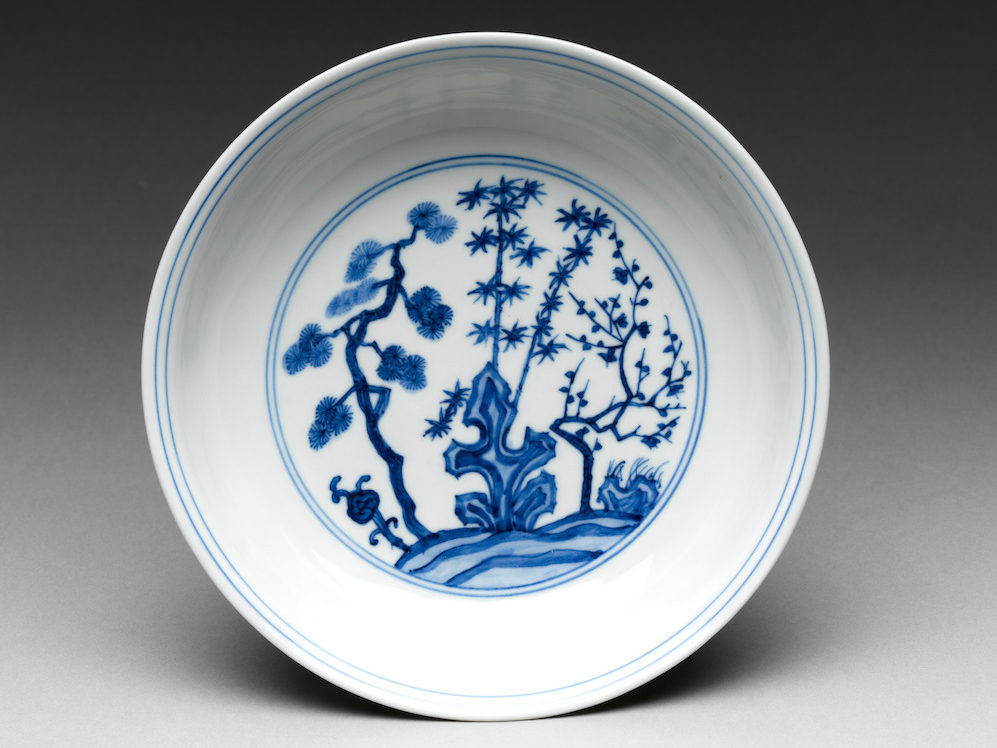
With the addition of the plum, the combination of bamboo and pine would indicate that the ewer embodied the auspicious meaning associated with the “three friends of winter.” Pine and bamboo are evergreens, and the appearance of plum blossoms in the late winter indicates spring’s imminent arrival. In the canon of Chinese auspicious design, the combination connotes steadfastness and resilience, ideal qualities ascribed to the Chinese scholar-gentleman.[20] Pine, bamboo, and plum appeared in every artistic medium in the late imperial period; for instance, they were painted in a neat line in underglaze blue on a Ming porcelain dish (Fig. 8). An inventory compiled in 1562 of the confiscated possessions of the Grand Secretary Yan Song 嚴嵩 (1480-1565) offers a rare insight into Ming Chinese classifications of gold- and silverware forms. Yan owned several thousand gold and silver vessels.[21] Each item is listed by form, then by decoration and weight. One gold vessel type included in the Yan Song inventory was a pair of “pine, bamboo, and plum ewers” (songzhumeihu 松竹梅壺). [22] They were listed within the capacious category of hu 壺, which included vessels for pouring wine, soup, tea, and water. While Yan’s ewers and the Versailles ewer were likely quite different, the listing in the inventory shows that metal ewers were classified by the auspicious motif.
The chrysanthemum-shaped finial on the Versailles ewer does not conform to the tripartite pattern; however, on the central relief panel described above, a lively, twisted plum tree completes the triad. Finials on related ewers of the same form, such as one in the K.L. Leung collection dating to the late seventeenth century, finish the trio as a twisted plum bough in blossom.[23] The qualities of the twisted plum tree are noted in the painter’s manual, the Manual of the Mustard Seed Garden (Jieziyuan Huapu 芥子園畫譜) (1679). Contrasted against the stasis of the trunk, the branches should be enervated with life: “Sinuous branches should give an impression of growing and stretching out.”[24] At the end of one passage, the plum is described as an embodiment of pine and bamboo: the “purity of the bamboo and the strength of the pine are manifest in the plum.”[25] If purity and strength are qualities made manifest in living trees and plants, the metalsmiths’ craft made inert metallic matter into an organic tangle of blossoms, branches, and pine sprays. The transformation qualities of the metal brought the object to life, as if to activate its symbolic meaning.
Chinese silversmiths pursued certain aesthetic potentials of silver to summon both worldly and numinous references through the songzhumei ewer. They developed layered, textural relief surfaces, which contrasted crisp, shiny, and smooth raised components against a matted ground. To make the handle, spout, and finials, they worked silver’s material properties of pliability and durability, drawing on its capacity to hold sculptural form. As a result, they experimented with entanglements between plant and metal, organic and inorganic matter. The external appendages served as a framing device for the frames of the surface panels, but in the physical enmeshment between the branches and the relief, they invited both visual and tactile exploration. Touching the handle of the ewer would make it black with use, as oils from the fingers tarnished the silver surface. As silver moved from one aesthetic potential to another, from lustrous shine to black, it might invite contemplation of the nature of wen and its material manifestations, from the pine bough to the ingot. The untouched bamboo spout would remain relatively bright. As such, it called attention not only to the transformational possibilities of silver—as it could be liquidated and turned into money at any moment—but also to those of craft, which could transmute metal into bamboo.

An enlivened concept of the auspicious ewer form, in its intertwinement of natural and artificial, was evidently part of a standard repertoire of elegant Chinese objects by around 1707, when a version was included in the decorative border of a Chinese lacquer screen (Figs. 9, 10).[26] Perhaps inspired by metalwork versions, the lacquer carver effectively imagined a similar relationship between the object’s relief surfaces and appendages as found on the Versailles ewer. The plum blossoms appear partially alive, with a gnarled branch for a spout and flowering branches on the body which grow into the handle. Though the lacquer carving only includes one component of the “three friends trio,” it shares the conceptual notion of how a drinking vessel could perform as an animate sculpture.
In Chinese contexts, the ewer form with a long, curving spout did not have a specific function, though it was likely most often used for serving wine or tea. A scene on the surface of an eighteenth-century pewter tea caddy provides insight into how such objects were used in spaces of refined consumption, here indicating elite male usage (Fig. 11). A figure sits at his repast under a pine tree. His servant is shown bringing him an ewer, which he will use to pour wine or tea into the man’s round cup. Further, the craft of gold- and silverwares both occluded and drew attention to silver’s monetary value, making them suitable for gifting under certain circumstances. In the late Ming novel The Plum in the Golden Vase, often used by scholars as a window into sixteenth-century elite material life, the main character used a set of gold and silver wine vessels to bribe the district magistrate.[27] Songzhumei ewers were desirable objects, and likely made appropriate, if lavish, gifts in refined masculine realms.
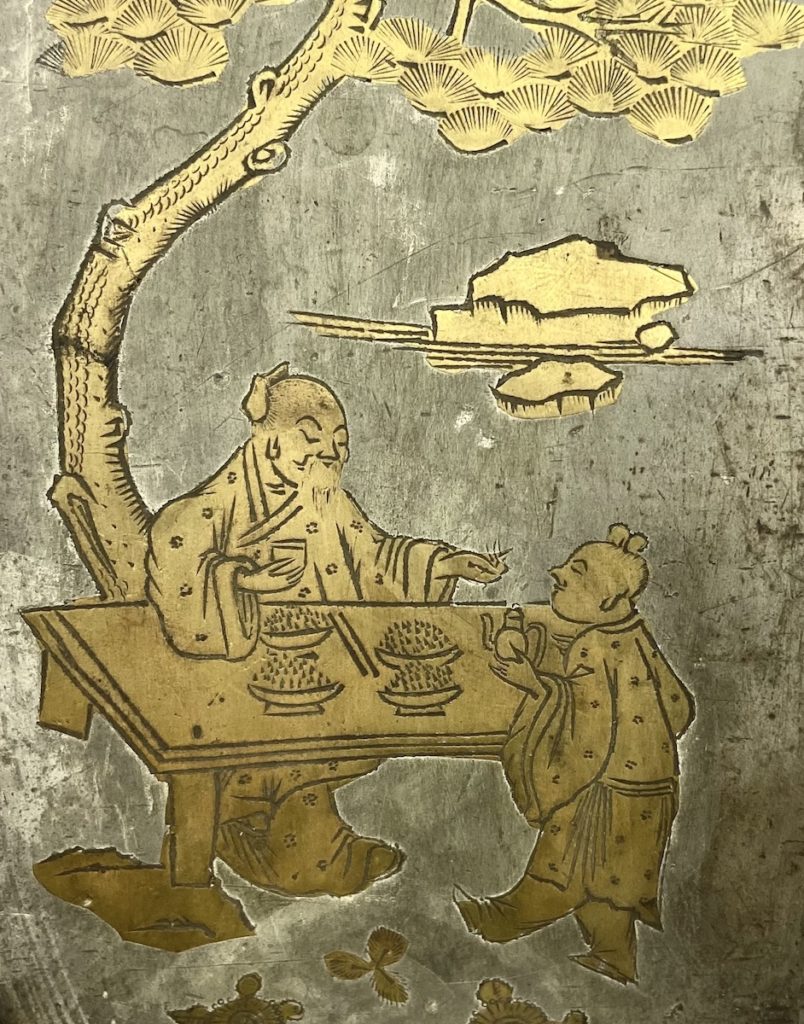
Their use, however, was not limited to masculine contexts of exchange. Another image of the ewer form appears on a Qing court painting on silk, dated around 1709 to 1723, of a Manchu court woman drinking tea in her private boudoir.[28] An ewer resting on a table to the right of the woman is obscured by a tree trunk. The ewer was painted in gold and silvery tones, likely conveying a gilded silver vessel. Its visible details resemble the organic forms of the Versailles ewer, including the bamboo spout, and the plum blossom and bamboo relief ornament.[29] The notion of wen as enfolded through metal and wood is also broached, as contrasting wood grains layer and frame the metal vessel. Visual sources in pewter, lacquer, and painting thus demonstrate how the object type could be used in different contexts of consumption. In the sections to follow, we turn from Chinese settings of elite drinking practices into the space of Phra Narai’s storerooms, tracing how the multivalent vessel was presented to European recipients through its re-classification as a Japanese chocolatière.
Packaging Gifts in Narai’s Storerooms: The Foreign Materials of Siamese Kingship
In the short-lived state relationship between the French and Siamese crowns at the close of the seventeenth century, diplomatic ceremonies were carefully orchestrated to negotiate regimes of power. Quantities of lavish gifts were required by Siamese protocol and given with the expectation of reciprocity. As was noted upon their reception in France, the gold and silver gifts were not Siamese manufactures. Some French courtiers complained that by gifting gold and silverwares described as Chinese and Japanese, the Siamese court was undermining its own status by presenting itself as lacking its own luxury production.[30] Yet from the view of the Siamese court, foreign luxuries were optimal expressions of regional power.
Phra Narai was remarkably fluid in his expressions of both sacred kingship and worldly cosmopolitanism. His was a Theravada Buddhist kingdom with a Brahmanic courtly culture; he claimed he was a descendent of the Khmer kings of Angkor, and yet during his coronation ceremony he was consecrated as a manifestation of the primary gods of the Hindu pantheon.[31] Beyond his pluralistic sacred authority, he was fascinated by how power was expressed materially by courts across Eurasia.[32] Among the Siamese nobility, foreign luxuries—both Asian and European—were essential displays of social status. Such objects included Japanese screens, French mirrors, Persian clothing and furnishings, and sundry exotica.[33] As George Vinal Smith wrote of Narai, his reign “was undoubtedly the most elaborate and luxurious” of the Ayutthaya kings. International trade and diplomacy, driven by the desire to source such goods, reached its height in the period.[34]
Differently from the French, the Siamese viewed diplomatic gifts as inalienable possessions of the king—as extensions of his royal persona.[35] Due to the Siamese emphasis placed on foreign luxury manufactures, the Chinese and Japanese gold- and silverwares selected directly from Narai’s palace and storehouses performed as such precisely through their commodity status, as fungible luxury objects. In other words, they were not sacred objects of court ritual. Rather, they were representatives of the worldly transactional abilities of the king.
During the preceding French mission to the Ayutthaya court in 1685, two European intermediaries spearheaded the selection of Siamese diplomatic gifts for the court of Louis XIV from Narai’s storerooms and palaces. French courtier and priest François-Timoléon de Choisy (1644-1724), known as the abbé de Choisy, made the selection with Constantin Phaulkon, the Greek adventurer acting at Narai’s court as chief minister. In Choisy’s memoir of the 1685 French embassy, he described how Phaulkon guided him through rooms of treasures assembled under different Siamese kings. According to Phaulkon, the treasure was indicative of that king’s social status and was never removed; “the king who, at his death, leaves the greatest treasure is more honored than the one who has won battles.”[36] In Narai’s own storehouses, their task was to choose “what is finest there” as presents for Louis XIV and his court.[37] What follows in Choisy’s memoir is an episodic account of dispersing the contents of Narai’s residences and storerooms. Given that Narai’s kingship was constituted through his luxury possessions, the symbols of his power—namely, his foreign-sourced possessions—were also remarkably redistributable.
Choisy’s role was to compile the official list of objects, and in doing so, he packaged them strategically for their French receivers. His accounts emphasized the special care taken with physically packing the precious metalwares:
All the gold and silver pieces are placed in large purses of Persian brocade; these are enclosed in others made of holland, and the lot are placed in japanned chests, placed inside ordinary chests, wrapped in oilcloth, tied with small strips of bamboo, and over each bale is a cow’s hide, covered with lime, to ward off the woodworm and ants in the ship.[38]
The layers of cases and wrapping were important qualifiers of the preciousness of the objects contained. His inventory also served as a form of packaging, and an abbreviated form of Choisy’s lists were likely published as Chaumont’s 1686 inventory. Choisy spent the morning of November 9, 1685 beginning to write out the list, which he noted, “will be a book” in its discerning description of objects, not “like a trader in the Rue Saint Denis.”[39] Choisy acknowledged the liminal status of luxury objects and diplomatic gifts, as they wavered between embodiments of the king’s power and legacy, artistic objects of great value, and commodities. The ways in which the Asian objects contained in the lists were described to the French both substantiated their value as luxuries and positioned them in relationship to their giver.
The discursive packaging of the Versailles ewer demonstrates how the naming of objects in the context of early modern global exchange could be expressions of power and hierarchy. Given Choisy’s close attention to objects and their origins, how might we evaluate the use of the term “Japan” in the 1686 inventory to describe the Chinese form of the Versailles ewer? In the sixteenth and seventeenth centuries, European descriptive terms for “foreignness” were remarkably fluid. Terms such as “Indian,” “Chinese” and “Japanese” were applied indiscriminately to objects sourced from Africa, Asia, and the Americas.[40] Choisy most likely used “Japan” as a laudatory term, due to its period association in Europe with high craftsmanship, particularly in lacquerwares.[41] None of the gold- or silverwares are described as Siamese, even though Siamese craftsmen produced niellowares, or silverwares with inlaid black designs, at a high level since the mid sixteenth century.[42] While he did distinguish between Chinese and Japanese metalwares, his system of ascribing differences in terms of origin or craft will perhaps never be known, unless more objects come to light.
In designating the objects as Chinese or Japanese, Choisy was likely following the advice of Phaulkon. The latter was deeply versed in the performance of Siamese diplomacy, and specifically in how the Siamese king positioned his polity as an importer rather than producer of luxury metalwares. Barry Flood’s notion of “cultural cross-dressing” can be extended to how the gold- and silverwares operated as material representatives of Narai’s kingship. Flood has written that clothing’s “incorporative qualities” could lead regional elites to appropriate the dress used as an expression of power in nearby areas.[43] The container’s enfolded cultural signifiers expressed through craft—its mutable status as a Japanese object taking a Chinese vessel form—effectively incorporated the Siamese king through his more powerful, East Asian counterparts, from whom he received manufactures as gifts as well as trading privileges.
Conclusion: Inventing the Americas in Asia
Choisy made a similar strategic choice by classifying the Chinese ewer as a chocolatière. Marcy Norton has argued that the practice of drinking chocolate had to be learned; its import to Europe was a “contingent accident of empire.”[44] The European taste for chocolate was initially cultivated in Spanish colonial American domestic spaces, where indigenous women introduced settler-colonizers to everyday Mesoamerican drinking practices.[45] Not just the botanical commodity, but the practice of preparing and drinking it, was exported to Europe. Chocolate was never imported on a large scale to China in the late seventeenth or eighteenth centuries. Most of the demand for the American drink in China came from Franciscan missionaries, who imported it through Manila.[46]
If the ewer was a novel Asian form, with surfaces and limbs of animated pine and plum flowers, then it seemed natural to connect it to new Asian and American medicinal products like cacao, coffee, and tea. In the late seventeenth century, the European logic in which the “Indies” were a single entity led to the publication of books that introduced readers to “Indian” products without any further geographical designation, such as Henry Stubbe’s The Indian Nectar, or a Discourse Concerning Chocolata (1662). Others grouped the three hot, caffeinated drinks together, such as du Blégny’s Le bon usage du thé, du caffé, et du chocolat pour la preservation & pour la guérison des maladies (1687), disregarding their disparate origins.[47] By transforming the Chinese songzhumei form into a chocolatière, at first glance it might seem that Choisy participated in the creation of what Elizabeth Horodowich and Alexander Nagel have termed an “Amerasian mirror”—a geographical and cultural imaginary of a global other, through which Europeans could both know and distinguish themselves.[48]
However, chocolate and other American plants also circulated throughout southeast Asia via Manila. For instance, Robert Parker, an English East India Company agent at Bantam, imported 190 casks of chocolate to Bantam on behalf of the archbishop of Manila as a gift in 1680.[49] Simon de la Loubère, a missionary who accompanied the 1685 French mission to Siam, reported that the Portuguese drank chocolate there, which had likewise been imported from the Americas via Manila.[50] Moreover, American crops such as avocado, maize, and tomato were introduced to southeast Asia via Spanish networks through the Philippines.[51] Some were successful in Siam; for example, the French missionary Nicolas Gervaise wrote of maize in 1688, “Although the cultivation of maize was only started [in Siam]…twelve or fifteen years ago, already vast plains are to be seen covered in it.”[52] By casting the ewer with a bamboo spout as a specialized vessel for preparing chocolate, Choisy and Phaulkon served the political interests of the Siamese court by creating a transpacific imaginary that linked Asia with the Americas. The phenomenon described as an “Amerasian mirror” was thus neither an exclusively European creation, nor did it necessarily invoke a bidirectional relationship of reflection. The cultural and political packaging of the Versailles ewer demonstrates that a transpacific material discourse could be mobilized toward different strategic ends.
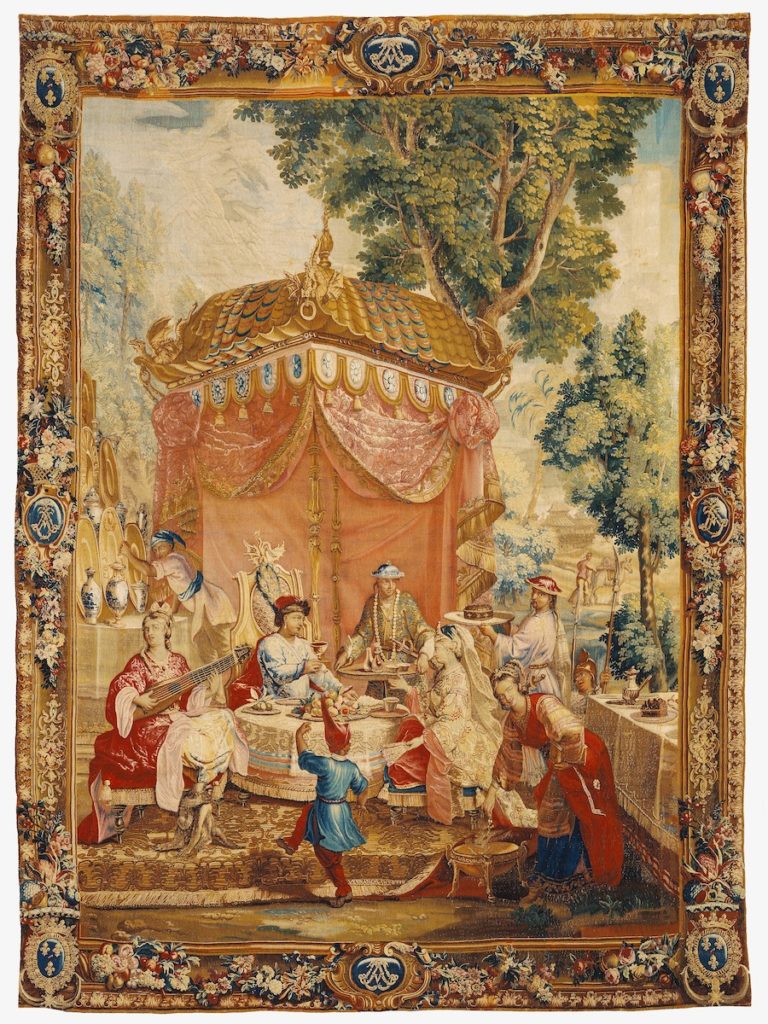
Namely, in sending the so-called, earliest-documented example of the chocolatière form to France, Narai and the Ayutthaya court were uniquely positioned at the center of the late seventeenth-century global luxury economy. As this case shows, intra-Asian circulations to the Americas, and the accompanying creation of transpacific imaginaries, either preceded or worked in collaboration with those produced in Europe. The effect of such articulations may have impacted the conceptual underpinnings of objects such as La Collation, from the Beauvais tapestry series The Story of the Emperor of China (Fig. 12).[53] Sitting under a tented awning, the Chinese Qianlong emperor (r. 1735-1796)—or rather, his French interpretation—is shown drinking a beverage. A French-style silver chocolate pot, complete with a vertical wooden handle, rests on the table at the right of the tapestry. Much like in the Sevin print, a European object is substituted for an Asian metalwork form. Nonetheless, chocolate from the Americas is here imagined as a luxurious drink customarily served at the Chinese court. While the songzhumei form of the Versailles ewer was never replicated by European goldsmiths on any scale, and Narai’s reign ended soon after the 1686 mission, together they produced an early cosmopolitan imaginary of a transpacific world, emerging from a southeast Asian vantage point.
Susan Eberhard is a Ph.D. candidate in the history of art at the University of California, Berkeley
Acknowledgments: I am grateful to Shivani Sud, Katherine Bruhn, Jon Soriano, and Todd Olson for their feedback on an earlier version of this essay. Presentations at the Getty Graduate Symposium and on Global Interchange: an online forum helped refine several arguments. Tara Zanardi and Agnieszka Ficek were extraordinarily generous, incisive editors. Special gratitude to Kee Il Choi, Jr., Karina Corrigan, Maria Menshikova, and Marie-Laure de Rochebrune. Research for this essay was supported by the CLIR/Mellon Dissertation Fellowship for Research in Original Sources and the Terra Foundation for American Art.
[1] Abbé de Choisy, Journal of a Voyage to Siam, 1685-6, trans. Michael Smithies (Oxford: Oxford University Press, 1993), 185.
[2] Representative studies include James L. Hevia, Cherishing Men from Afar: Qing Guest Ritual and the Macartney Embassy of 1793 (Durham, N.C.: Duke University Press, 1995); Cecily Hilsdale, Byzantine Art and Diplomacy in an Age of Decline (Cambridge: Cambridge University Press, 2014); and Global Gifts: The Material Culture of Diplomacy in Early Modern Eurasia, eds. Zoltán Biedermann, Anne Gerritsen, and Giorgio Riello (Cambridge: Cambridge University Press, 2017).
[3] Giorgio Riello, “With Great Pomp and Magnificence: Royal Gifts and Embassies between Siam and France in the Late Seventeenth Century,” in Global Gifts, 242.
[4] The sole other extant object connected to the mission is a mounted jade in the collection of the Prado. See Leticia Arbeteta, “Tesoro del delfín. Una herencia de la familia real francesa,” in Los tesoros ocultos del Museo del Prado (Madrid: Fundación Amigos del Museo del Prado, 2017), 248-276.
[5] My methodological approach is indebted to Cecily J. Hilsdale; see “The Social Life of the Byzantine Gift: The Royal Crown of Hungary Re-Invented,” Art History 31:5 (November 2008): 605.
[6] See Michael Smithies, The Discourses at Versailles of the First Siamese Ambassadors to France, 1686-7, together with the list of their presents to the court, ed. Michael Smithies (Bangkok: Siam Society, 1986), 70-96.
[7] Riello, “With Great Pomp and Magnificence,” 242; Meredith Martin, “Mirror Reflections: Louis XIV, Phra Narai, and the Material Culture of Kingship,” Art History 38:4 (September 2015): 664.
[8] Marie-Laure de Rochebrune, “Un trésor retrouvé: une verseuse chinoise en argent, offerte par les ambassadeurs du Siam à Louis XIV le 1er septembre 1686, revient à Versailles,” Revue du Louvre et des musées de France 1 (2019): 59.
[9] Sophie and Michael Coe, The True History of Chocolate, 2nd. ed. (London: Thames and Hudson, 2007), 159.
[10] de Rochebrune, “Un trésor retrouvé,” 58.
[11] See Arjun Appadurai, “Introduction: Commodities and the Politics of Value,” from The Social Life of Things: Commodities in Cultural Perspective, ed. Appadurai (New York: Cambridge University Press, 1986), 3-63; Igor Kopytoff, “The Cultural Biography of Things: Commoditization as Process,” in The Social Life of Things, 64-91.
[12] Le bon usage du thé, du caffé, et du chocolat pour la preservation & pour la guérison des maladies (Paris, 1687), 265-266.
[13] Author correspondence with Maria Menshikova, August 23, 2022. For a description of the inventory, see Maria Menshivkova, Silver Wonders from the East: Filigree of the Tsars (Altershot, UK: Lund Humpries in Association with Hermitage Amsterdam, 2006), 37. Also see Treasures of Catherine the Great, ed. Mikhail B. Piotrovski (New York: Harry N. Abrams, Inc., 2000), 221-228.
[14] Ho Wing Meng, Straits Chinese Silver: A Collector’s Guide (Singapore: Times Books International, 1984), 148-160.
[15] See H.A. Crosby Forbes, “Chinese Export Silver for the British Market, 1660-1780,” Transactions of the Oriental Ceramic Society 63 (1998-9): 5-7; Treasures of Catherine the Great, 221.
[16] “Materiality as decor: aesthetics, semantics, and function,” in Materiality in Roman Art and Architecture: Aesthetics, Semantics and Function, eds. Annette Haug, Adrian Hielscher and M. Taylore Lauritsen (De Gruyter, 2022), 5.
[17] Sarah Handler, Austere Luminosity of Chinese Classical Furniture (Berkeley and Los Angeles: University of California Press, 2001), 77.
[18] Jonathan Hay, Sensuous Surfaces: The Decorative Object in Early Modern China (London: Reaktion Books Ltd., 2010),130.
[19] Bruce Rusk, “Value and Validity: Seeing through Silver in Late Imperial China,” in Powerful Arguments, eds. Martin Hofmann, Joachim Kurtz, and Ari Daniel Levine, Sinica Leidensia (Leiden: Brill, 2020), 483fn25.
[20] Terese Tse Bartholomew, Hidden Meanings in Chinese Art (San Francisco: Asian Art Museum, 2006), 210.
[21] Jane Portal, “Decorative Arts for Display,” in The British Museum Book of Chinese Art, ed. Jessica Rawson (London: British Museum Press, 1992), 187.
[22] Tianshui bingshan lu: Fu Qianshantang shuhuaji, vol. 1 (Shanghai: Gushuliutongchu, 1921).
[23] See The Silver Age: Origins and Trade of Chinese Export Silver, ed. Libby Lai-Pik Chan with Nina Lai-Na Wan (Hong Kong: Hong Kong Maritime Museum, 2017), 40.
[24] The Mustard Seed Garden Manual of Painting: A Facsimile of the 1887-1888 Shanghai Edition, trans. and ed. Mai-mai Sze (Princeton, NJ: Princeton University Press, 2015), 403.
[25] The Mustard Seed Garden Manual of Painting, 403.
[26] Thanks to Kee Il Choi, Jr., for bringing this object reference and image to my attention.
[27] The Plum in the Golden Vase or, Chin P’ing Mei, Volume One: The Gathering, trans. David Tod Roy (Princeton, NJ: Princeton University Press, 2013), 189.
[28] Wen-chien Cheng, “Idealized Portraits of Women for the Qing Imperial Court,” Orientations 45:4 (May 2014): 92-99. The painting is one of a series of twelve large paintings depicting idealized beautiful women, a genre known as meiren hua. The paintings were commissioned by the Yongzheng emperor (r. 1722-1735) when he was a prince. The identities of the women, if they existed, are unknown.
[29] Researchers have connected more than twenty objects depicted in the series to extant objects in the palace museums in both Beijing and Taipei, suggesting that the gilded silver ewer may have been a court possession. Cheng, “Idealized Portraits,” 97.
[30] Riello, “With Great Pomp and Magnificence,” 245.
[31] Alan Strathern, “Sacred Kingship under King Narai of Ayutthaya: Divination and Righteousness,” Journal of the Siam Society 107:1 (2019): 57-58.
[32] Martin, “Mirror Reflections,” 655.
[33] Riello, “With Great Pomp and Magnificence,” 257.
[34] George Vinal Smith, The Dutch in Seventeenth-Century Thailand (DeKalb: Northern Illinois University, 1977), 73-74.
[35] Riello, “With Great Pomp and Magnificence,” 261.
[36] Vinal Smith, The Dutch in Seventeenth-Century Thailand, 174-5.
[37] Vinal Smith, The Dutch in Seventeenth-Century Thailand, 174.
[38] Choisy, Journal of a Voyage to Siam,183.
[39] Choisy, Journal of a Voyage to Siam,183.
[40] Jessica Keating and Lia Markey, “’Indian’ Objects in Medici and Austrian-Habsburg Inventories: A Case Study of the Sixteenth-Century Term,” Journal of the History of Collections 23:2 (2011): 283-300.
[41] For changing French perceptions of Japanese lacquer from the late seventeenth to the eighteenth centuries, see Kristina Kleutghen, “Imports and Imitations: The Taste for Japanese Lacquer in Eighteenth-Century China and France,” The Journal for Early Modern Cultural Studies 17:2 (Spring 2017): 177-180.
[42] Paul Bromberg, Thai Silver and Nielloware (Bangkok: River Books Co., Ltd, 2019),44, 58.
[43] Objects of Translation: Material Culture and Medieval “Hindu-Muslim” Encounter (Princeton: Princeton University Press, 2000), 63.
[44] Marcy Norton, “Tasting Empire: Chocolate and the European Internalization of Mesoamerican Aesthetics,” The American Historical Review 111:3 (June 2006): 670.
[45] Norton, “Tasting Empire,” 677-678.
[46] Bertram M. Gordon, “Chinese Chocolate: Ambergris, Emperors, and Export Ware,” in Chocolate: History, Culture, and Heritage, eds. Louis E. Grivetti and Howard-Yana Shapiro (Hoboken, N.J.: Wiley, 2009),595-596.
[47] Christine A. Jones, “Exotic Edibles: Coffee, Tea, Chocolate, and the Early Modern French How-to,” Journal of Medieval and Early Modern Studies 43:3 (Fall, 2013): 623-625.
[48] Horodowich and Nagel, “Amerasia: European Reflections of an Emergent World, 1492-ca.1700,” Journal of Early Modern History 23 (2019): 258-260.
[49] National Archives, E 140/9/4, volume 2, folio 14.
[50] de la Loubère, The Kingdom of Siam (Singapore: Oxford University Press, 1969), 23.
[51] de la Loubère, The Kingdom of Siam, 596.
[52] The Natural and Political History of the Kingdom of Siam, trans. and ed. by John Villiers (Bangkok: White Lotus Co., Ltd., 1989), 19-20.
[53] For a recent study of these tapestries, see Florian Knothe, Pascal-François Bertrand, Kristel Smentek, and Nicholas Pearce, Imagining Qianlong: Louis XV’s Chinese Emperor Tapestries and Battle Scene Prints at the Imperial Court in Beijing (Hong Kong: Hong Kong University Press, 2017).
Cite this article as: Susan Eberhard, “The Asian Silver Chocolatière: The Transpacific World in a Diplomatic Gift,” Journal18, Issue 14 Silver (Fall 2022), https://www.journal18.org/6528.
Licence: CC BY-NC
Journal18 is published under a Creative Commons CC BY-NC International 4.0 license. Use of any content published in Journal18 must be for non-commercial purposes and appropriate credit must be given to the author of the content. Details for appropriate citation appear above.

